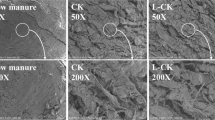Abstract
In this study, we investigated the Sb(V) adsorption on ferrihydrite (Fh) at different pH values, in the presence and absence of common competing anions in soil such as phosphate (P(V)) and arsenate (As(V)). Batch adsorption experiments, carried out at pH 4.5, 6.0, and 7.0, showed a greater affinity of Fh towards P(V) and As(V) with respect to Sb(V), especially at higher pH values, while the opposite was true at acidic pH. The capacity of Fh to accumulate greater amounts of phosphate and arsenate in the 6.0–7.0 pH range was mainly linked to the different acid properties of P(V), As(V), and Sb(V) oxyanions. The Sb(V) adsorption on Fh was highly pH-dependent and followed the following order: pH 4.5 (0.957 mmol·g−1 Fh) > pH 6.0 (0.701 mmol·g−1 Fh) > pH 7.0 (0.583 mmol·g−1 Fh). Desorption of antimonate from Sb(V)-saturated Fh, treated with citric and malic acid solutions, was ~equal to 55, 68, and 76% of that sorbed at pH 4.5, 6.0, and 7.0, respectively, while phosphate, arsenate, and sulfate were able to release significantly lower Sb(V) amounts. The FT-IR spectra revealed substantial absorbance shifts related to the surface hydroxyl groups of Fh, which were attributed to the formation of Fe-O-Sb(V) bonds and supported the formation of inner-sphere bonding between Sb(V) and Fh.






Similar content being viewed by others
References
Ahmad M, Rajapaksha AU, Lim JE, Zhang M, Bolan N, Mohan D, Vithanage M, Lee SS, Ok YS (2014) Biochar as a sorbent for contaminant management in soil and water: a review. Chemosphere 99:19–33
Bai Y, Jefferson WA, Liang J, Yang T, Qu J (2017) Antimony oxidation and adsorption by in-situ formed biogenic Mn oxide and Fe–Mn oxides. J Environ Sci 54:126–134
Bentley R, Chastee TG (2002) Microbial methylation of metalloids: arsenic, antimony, and bismuth. Microbiol Mol Biol Rev 66(2):250–271
Castaldi P, Silvetti M, Garau G, Deiana S (2012) Simultaneous sorption of phosphate and arsenate by red muds (a bauxite ore processing waste). Fresenius Environ Bull 21(3a):713–722
Castaldi P, Silvetti M, Mele E, Garau G, Deiana S, (2013) Arsenic mobilization by citrate and malate from a red mud–treated contaminated soil. J Environ Qual 42 (3):774–781
Castaldi P, Mele E, Silvetti M, Garau G, Deiana S (2014) Water treatment residues as accumulators of oxoanions in soil. Sorption of arsenate and phosphate anions from an aqueous solution. J Hazard Mater 264:144–152
Castaldi P, Garau G, Lauro GP, Pigna M, Violante A, Deiana S (2015) Role of root exudates on the sorption of arsenate by ferrihydrite. Eur J Soil Sci 66(4):813–822
Castaldi P, Diquattro S, Lauro GP, Marceddu S, Garau G (2018) Water treatment residuals as a resource for the recovery of soil and water polluted with Sb(V): sorption and desorption trials at different pH values. Water Air Soil Pollut 229(6):174
Chorover J, Brusseau ML (2008) Kinetics of sorption–desorption. In: Kinetics of Water–Rock Interaction. Spinger, New York, pp 109–149
Cidu R, Biddau R, Dore E, Vacca A, Marini L (2014) Antimony in the soil–water–plant system at the Su Suergiu abandoned mine (Sardinia, Italy): strategies to mitigate contamination. Sci Total Environ 319:497–498
Diquattro S, Garau G, Lauro GP, Silvetti M, Deiana S, Castaldi P (2018) Municipal solid waste compost as a novel sorbent for antimony(V): adsorption and release trials at acidic pH. Environ Sci Pollut Res 25:5603–5615
Dore E, Frau F (2018) Antimonate uptake by calcined and uncalcined layered double hydroxides: effect of cationic composition and M2+/M3+ molar ratio. Environ Sci Pollut Res 25:916–929
Dou X, Zhang Y, Wang H, Wang T, Wang Y (2011) Performance of granular zirconium–iron oxide in the removal of fluoride from drinking water. Water Res 45(12):3571–3578
Dousova B, Lhotka M, Filip J, Kolousek D (2018) Removal of arsenate and antimonate by acid–treated Fe–rich clays. J Hazard Mater 357:440–448
Filella M, Belzile N, Che YW (2002a) Antimony in the environment: a review focused on natural waters I. Occurrence. Earth Sci Rev 57:125–176
Filella M, Belzile N, Chen YW (2002b) Antimony in the environment: a review focused on natural waters: II. Relevant solution chemistry. Earth Sci Rev 59:265–285
Filella M, Philippo S, Belzile N, Chen Y, Quentel F (2009) Natural attenuation processes applying to antimony: a study in the abandoned mine of Goesdorf, Luxembourg. Sci Total Environ 407(24):6205–6216
Garau G, Silvetti M, Vasileiadis S, Donner E, Diquattro S, Deiana S, Lombi E, Castaldi P (2017) Use of municipal solid wastes for chemical and microbiological recovery of soils contaminated with metal(loid)s. Soil Biol Biochem 111:25–35
Goldberg S, Sposito G (1985) On the mechanism of specific phosphate adsorption by hydroxylated mineral surfaces: a review. Commun Soil Sci Plant Anal 16(8):801–821
Guo X, Wu Z, He M, Meng X, Jin X, Qiu N, Zhang J (2014) Adsorption of antimony onto iron oxyhydroxides: adsorption behavior and surface structure. J Hazard Mater 276:339–345
Guo W, Fu Z, Wang H, Liu S, Wu F, Giesy JP (2018) Removal of antimonate (Sb(V)) and antimonite (Sb(III)) from aqueous solutions by coagulation–flocculation–sedimentation (CFS): dependence on influencing factors and insights into removal mechanisms. Sci Total Environ 644:1277–1285
Herath I, Vithanage M, Bundschuh J (2017) Antimony as a global dilemma: geochemistry, mobility, fate and transport. Environ Pollut 223:545–559
Ilgen G, Trainor TP (2012) Sb(III) and Sb(V) sorption onto Al–rich phases: hydrous al oxide and the clay minerals kaolinite KGa–1b and oxidized and reduced nontronite NAu–1. Environ Sci Technol 46:843–851
Jianhong X, Mengchang H, Kunpeng W, Guizhi Z (2013) Adsorption of antimony(III) on goethite in the presence of competitive anions. J Geochem Explor 132:201–208
Jones DL (1998) Organic acids in the rhizosphere – a critical review. Plant Soil 205:25–44
Kuzyakov Y, Blagodatskaya E (2015) Microbial hotspots and hot moments in soil: Concept & review. Soil Biol Biochem 83:184–199
Leuz AK, Monch H, Johnson CA (2006) Sorption of Sb(III) and Sb(V) to goethite: influence on Sb(III) oxidation and mobilization. Environ Sci Technol 40:7277–7282
McComb KA, Craw D, McQuillan AJ (2007) ATR–IR spectroscopic study of antimonate adsorption to iron oxide. Langmuir 23(24):12125–12130
Mitsunobu S, Muramatsu C, Watanabe K, Sakata M (2013) Behavior of antimony(V) during the transformation of ferrihydrite and its environmental implications. Environ Sci Technol 47:9660–9667
Nakamaru Y, Tagami K, Uchida S (2006) Antimony mobility in Japanese agricultural soils and the factors affecting antimony sorption behavior. Environ Pollut 141:321–326
Onireti OO, Lin C (2016) Mobilization of soil–borne arsenic by three common organic acids: dosage and time effects. Chemosphere 147:352–360
Sposito G (2008) The Chemistry of Soils, 2nd edn. Oxford University Press, New York
Stevenson FJ (1994) Humus Chemistry, Genesis, Composition, Reactions, 2nd edn. John Wiley & Sons, New York
van Genuchten CM, Peña J (2016) Antimonate and arsenate speciation on reactive soil minerals studied by differential pair distribution function analysis. Chem Geol 429:1–9
Vithanage M, Rajapaksha AU, Dou X, Bolan NS, Yang JE, Ok YS (2013) Surface complexation modeling and spectroscopic evidence of antimony adsorption on iron–oxide–rich red earth soils. J Colloid Interf Sci 406:217–224
Wang QS, He MC, Wang Y (2011) Influence of combined pollution of antimony and arsenic on culturable soil microbial populations and enzyme activities. Ecotoxicology 20:9–19
Wilson NJ, Craw D, Hunter K (2004) Antimony distribution and environmental mobility at an historic antimony smelter site, New Zealand. Environ Pollut 129(2):257–266
Wilson SC, Lockwood PV, Ashley PM, Tighe M (2010) The chemistry and behaviour of antimony in the soil environment with comparisons to arsenic: a critical review. Environ Pollut 158:1169–1181
Wu D, Sun S-P, He M, Wu Z, Xiao J, Dong Chen X, Wu DW (2018) As(V) and Sb(V) co–adsorption onto ferrihydrite: synergistic effect of Sb(V) on As(V) under competitive conditions. Environ Sci Pollut Res 25:14585–14594
Zhang Y, Yang M, Dou XM, He H, Wang DS (2005) Arsenate adsorption on an Fe−Ce bimetal oxide adsorbent: role of surface properties. Environ Sci Technol 39(18):7246–7253
Zhu J, Pigna M, Cozzolino V, Caporale AG, Violante A (2011) Sorption of arsenite and arsenate on ferrihydrite: effect of organic and inorganic ligands. J Hazard Mater 189:564–571
Author information
Authors and Affiliations
Corresponding author
Additional information
Responsible editor: Tito Roberto Cadaval Jr
Publisher’s note
Springer Nature remains neutral with regard to jurisdictional claims in published maps and institutional affiliations.
Research highlights
Sb(V), P(V), and As(V) were sorbed by ferrihydrite (Fh) at pH 4.5, 6.0, and 7.0.
Sb(V) sorption by Fh was more pH-dependent compared to As(V) and P(V).
More stable Sb(V)-Fh complexes were formed at lower pH values.
Common soil organic anions released more Sb(V) from Fh with respect to inorganic ones.
Significant amounts of Sb(V) were retained by Fh through strong chemical interactions.
Rights and permissions
About this article
Cite this article
Garau, G., Lauro, G.P., Diquattro, S. et al. Sb(V) adsorption and desorption onto ferrihydrite: influence of pH and competing organic and inorganic anions. Environ Sci Pollut Res 26, 27268–27280 (2019). https://doi.org/10.1007/s11356-019-05919-z
Received:
Accepted:
Published:
Issue Date:
DOI: https://doi.org/10.1007/s11356-019-05919-z




